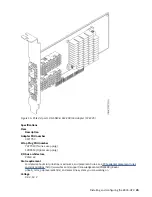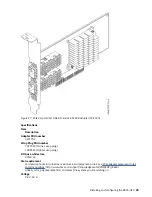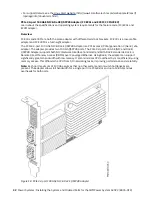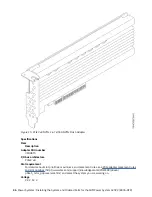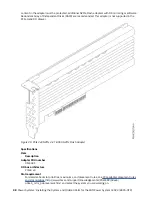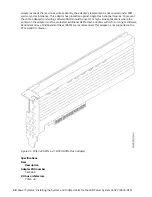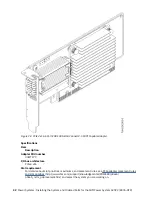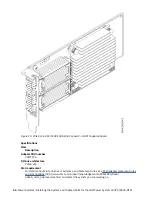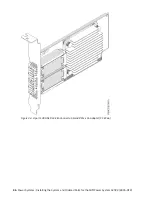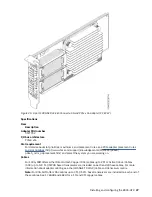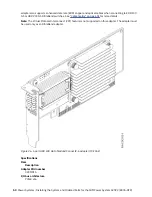
Form factor
Short, low-profile (FC EC5A, EC5G, and EC6U).
Short, with full-height tail stock (FC EC5B and EC6V).
Maximum number
For details about the maximum number of adapters that are supported, see PCIe adapter placement
rules and slot priorities (http://www.ibm.com/support/knowledgecenter/POWER9/p9eab/
p9eab_mtm_pciplacement.htm) and select the system you are working on.
Attributes provided
1.6 TB of low latency flash memory.
Non-Volatile Write Buffer.
Hot Plug Capable.
Operating system or partition requirements
If you are installing a new feature, ensure that you have the software that is required to support the new
feature and that you determine whether any prerequisites must be met for this feature and attaching
devices. For information about operating system and partition requirements, see one of the following
topics:
• The latest version of enabling libraries and utilities can be downloaded from Fix Central (http://
www.ibm.com/support/fixcentral/).
• Power Systems Prerequisites (http://www14.software.ibm.com/support/customercare/iprt/home).
• IBM SSIC (System Storage Interoperation Center) (http://www-03.ibm.com/systems/support/storage/
ssic/interoperability.wss).
• The latest version of the device driver or IBM Power RAID adapter utilities (iprutils) can be downloaded
from the IBM Service and Productivity Tools website (http://www14.software.ibm.com/webapp/
set2/sas/f/lopdiags/home.html).
• For support details, see the Linux Alert website (http://www14.software.ibm.com/webapp/set2/sas/f/
lopdiags/info/LinuxAlerts.html).
PCIe3 x8 NVMe 3.2 TB SSD NVMe Flash Adapter (FC EC5C, EC5D, EC6W, and EC6X; CCIN 58FD)
Learn about the specifications and operating system requirements for feature code (FC) EC5C, EC5D,
EC6W, and EC6X adapters. FC EC5C and EC6W are low-profile adapters and FC EC5D and EC6X are full-
height adapters. FC EC5C and EC5D are supported on AIX or Linux operating systems. FC EC6W and EC6X
are supported on the IBM i operating system.
Overview
The PCIe3 x8 NVMe 1.6 TB SSD NVMe adapter is a Peripheral Component Interconnect Express (PCIe)
generation 3 (Gen3) x8 adapter. The adapter can be used in either a x8 or x16 PCIe (Gen3) slot in the
system and uses Non-Volatile Memory Express (NVMe). NVMe is a high-performance software interface
that can read or write flash memory. Compared to a Serial-attached SCSI (SAS) or Serial Advanced
Technology Attachment (SATA) solid-state drive (SSD), the NVMe Flash adapter provides more read or
write, input or output operations per second (IOPS) and larger throughput (GB/sec). The type of workload
has a great impact on the maximum write capacity. If a high percentage of more sequentially oriented
write operations are performed instead of random write operations, the maximum write capacity will be
large. To extend the life of the NVMe device, the application that is using the NVMe device must convert
small random write operations to larger sequential write operations. The write operations that exceed the
maximum write capacity of the adapter continues to operate for some time but the performance will be
slow. The life of the device is not affected depending on whether the application uses sequential oriented
write operations or random read operations from the device. A Predictive Failure Analysis message is
displayed when the adapter that is enabled by the system administrator must be replaced. To monitor the
percentage usage of the adapter, see Checking the amount of remaining life in NVMe devices. If the
adapter exceeds the maximum write capability, the adapter's replacement is not covered under IBM
warranty or maintenance. This adapter has protection against single Flash channel failures. To prevent
the entire adapter from failing, software RAID should be used. For high-value applications where the
Installing and configuring the 8335-GTX 37
Summary of Contents for Power System AC922
Page 4: ...iv...
Page 105: ...or or or or Installing and configuring the 8335 GTX 91...
Page 137: ......
Page 138: ...IBM...



